Page 11 of 358
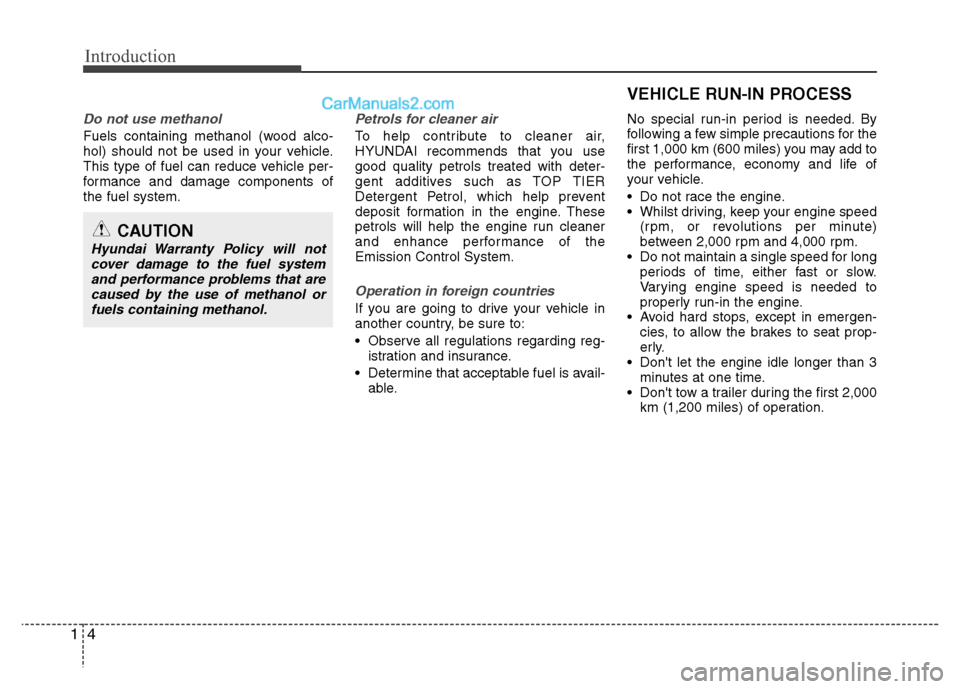
Introduction
4
1
Do not use methanol
Fuels containing methanol (wood alco-
hol) should not be used in your vehicle.
This type of fuel can reduce vehicle per-
formance and damage components ofthe fuel system.
Petrols for cleaner air
To help contribute to cleaner air,
HYUNDAI recommends that you usegood quality petrols treated with deter-
gent additives such as TOP TIER
Detergent Petrol, which help prevent
deposit formation in the engine. These
petrols will help the engine run cleaner
and enhance performance of theEmission Control System.
Operation in foreign countries
If you are going to drive your vehicle in
another country, be sure to:
Observe all regulations regarding reg-
istration and insurance.
Determine that acceptable fuel is avail- able. No special run-in period is needed. By
following a few simple precautions for the
first 1,000 km (600 miles) you may add to
the performance, economy and life of
your vehicle.
Do not race the engine.
Whilst driving, keep your engine speed
(rpm, or revolutions per minute)
between 2,000 rpm and 4,000 rpm.
Do not maintain a single speed for long periods of time, either fast or slow.
Varying engine speed is needed to
properly run-in the engine.
Avoid hard stops, except in emergen- cies, to allow the brakes to seat prop-
erly.
Don't let the engine idle longer than 3 minutes at one time.
Don't tow a trailer during the first 2,000 km (1,200 miles) of operation.
CAUTION
Hyundai Warranty Policy will not
cover damage to the fuel systemand performance problems that arecaused by the use of methanol or
fuels containing methanol.
VEHICLE RUN-IN PROCESS
Page 12 of 358
15
Introduction
INDICATOR SYMBOLS ON THE INSTRUMENT CLUSTER
Seat belt warning light (if equipped)
High beam indicator
Turn signal indicator
ABS warning light (if equipped)
Parking brake & Brake fluid warning light
Engine oil pressure warning light
ESP indicator (if equipped)
ESP OFF indicator (if equipped)
Malfunction indicator light
Air bag warning light (if equipped)
Cruise indicator (if equipped)
Cruise SET indicator (if equipped)
Immobiliser indicator (if equipped)
Low fuel level warning light
* For more detailed explanations, refer to “Instrument cluster” in section 4.
Charging system warning light Overspeed warning light (if equipped)
120km/h
Tail light indicator
Trunk ajar warning light
Front fog light indicator (if equipped)
Page 14 of 358
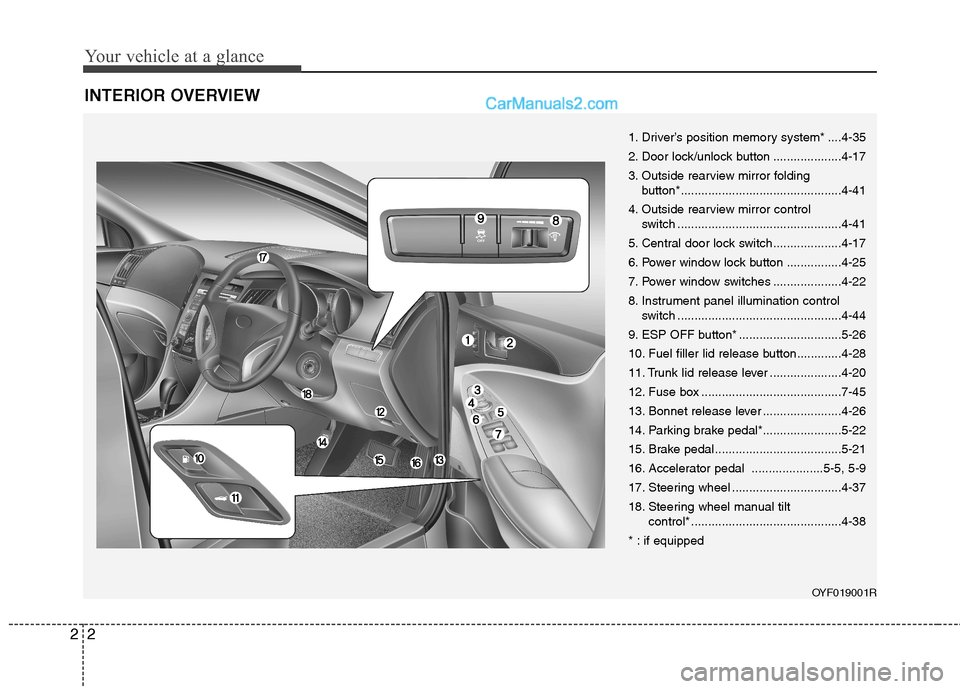
Your vehicle at a glance
2
2
INTERIOR OVERVIEW
1. Driver’s position memory system* ....4-35
2. Door lock/unlock button ....................4-17
3. Outside rearview mirror folding
button*...............................................4-41
4. Outside rearview mirror control switch ................................................4-41
5. Central door lock switch....................4-17
6. Power window lock button ................4-25
7. Power window switches ....................4-22
8. Instrument panel illumination control switch ................................................4-44
9. ESP OFF button* ..............................5-26
10. Fuel filler lid release button.............4-28
11. Trunk lid release lever .....................4-20
12. Fuse box .........................................7-45
13. Bonnet release lever .......................4-26
14. Parking brake pedal*.......................5-22
15. Brake pedal .....................................5-21
16. Accelerator pedal .....................5-5, 5-9
17. Steering wheel ................................4-37
18. Steering wheel manual tilt control* ............................................4-38
* : if equipped
OYF019001R
Page 16 of 358
Your vehicle at a glance
4
2
ENGINE COMPARTMENT
1. Power steering fluid reservoir ...........7-22
2. Engine coolant reservoir ...................7-18
3. Windscreen washer fluid reservoir....7-23
4. Radiator cap .....................................7-20
5. Engine oil filler cap ...........................7-16
6. Engine oil dipstick .............................7-16
7. Brake/clutch fluid reservoir ...............7-21
8. Air cleaner.........................................7-25
9. Fuse box ...........................................7-4410.
Positive battery terminal.................7-31
11. Negative battery terminal ..............7-31
OYF019003R/OYF079060R-1
■■
2.0L
■
■ 2.4L
Page 32 of 358
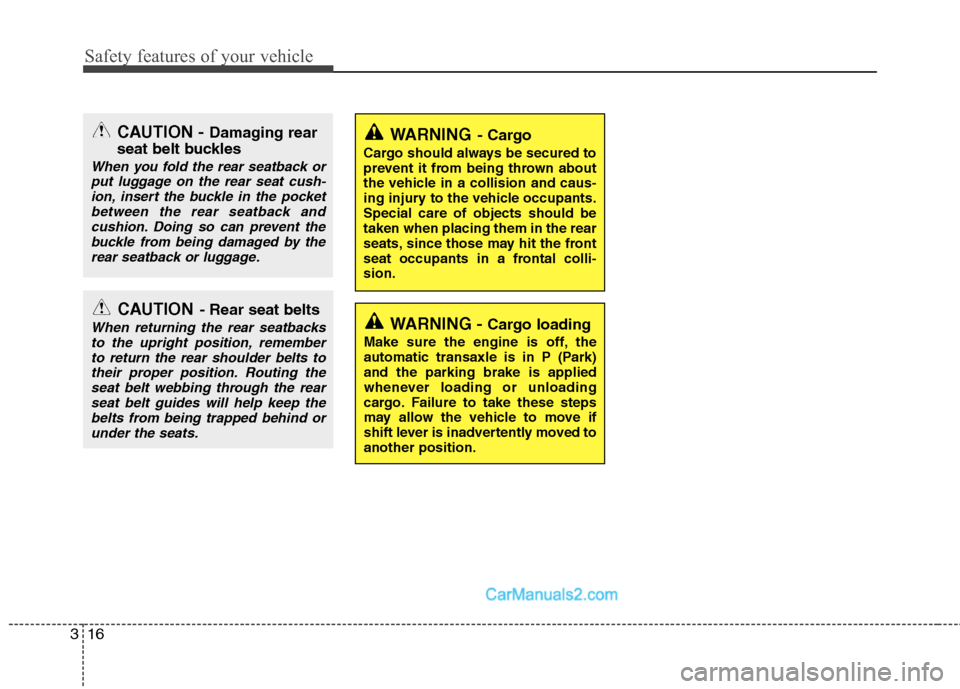
Safety features of your vehicle
16
3
WARNING - Cargo loading
Make sure the engine is off, the
automatic transaxle is in P (Park)and the parking brake is applied
whenever loading or unloading
cargo. Failure to take these steps
may allow the vehicle to move if
shift lever is inadvertently moved toanother position.
WARNING - Cargo
Cargo should always be secured to
prevent it from being thrown about
the vehicle in a collision and caus-
ing injury to the vehicle occupants.Special care of objects should betaken when placing them in the rear
seats, since those may hit the front
seat occupants in a frontal colli-sion.
CAUTION - Rear seat belts
When returning the rear seatbacks
to the upright position, rememberto return the rear shoulder belts totheir proper position. Routing the
seat belt webbing through the rearseat belt guides will help keep thebelts from being trapped behind orunder the seats.
CAUTION - Damaging rear
seat belt buckles
When you fold the rear seatback or put luggage on the rear seat cush-
ion, insert the buckle in the pocketbetween the rear seatback andcushion. Doing so can prevent the buckle from being damaged by the
rear seatback or luggage.
Page 69 of 358
353
Safety features of your vehicle
Just before impact, drivers often brakeheavily. Such heavy braking lowers the
front portion of the vehicle causing it to
“ride” under a vehicle with a higher
ground clearance. Air bags may not
inflate in this "under-ride" situation
because deceleration forces that are
detected by sensors may be signifi-
cantly reduced by such “under-ride”
collisions. Air bags may not inflate in rollover acci-
dents because air bag deployment
would not provide protection to the
occupants.
However, side impact and curtain air bags may inflate when the vehicle is
rolled over by a side impact collision, if
the vehicle is equipped with side
impact air bags and curtain air bags. Air bags may not inflate if the vehicle
collides with objects such as utility
poles or trees, where the point of
impact is concentrated to one area and
the full force of the impact is not deliv-
ered to the sensors.
1JBA35171JBA35221JBA3518
Page 88 of 358
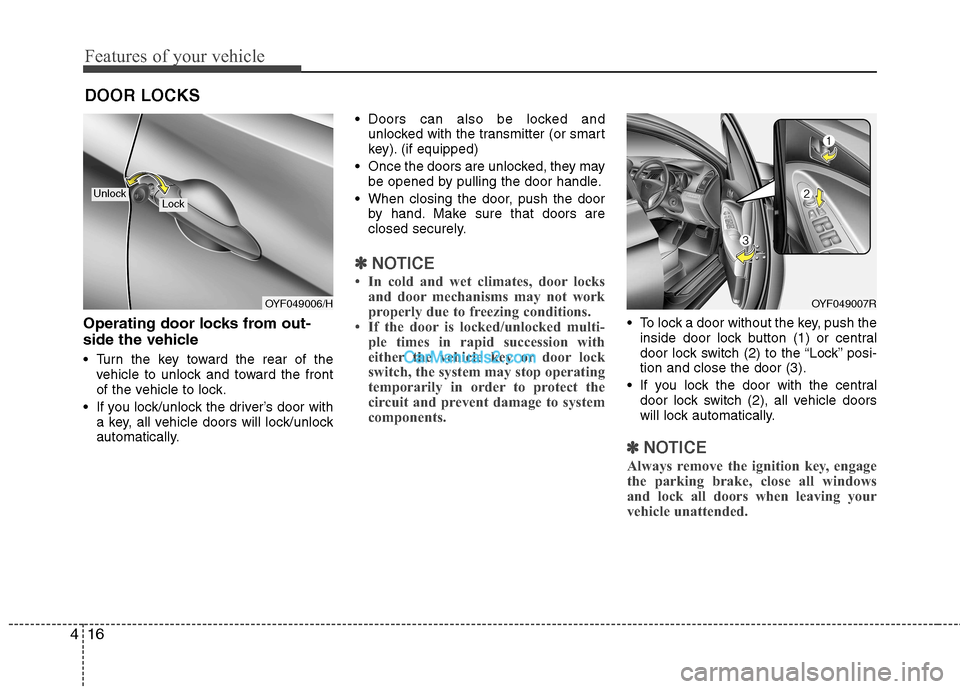
Features of your vehicle
16
4
Operating door locks from out-
side the vehicle
Turn the key toward the rear of the
vehicle to unlock and toward the front
of the vehicle to lock.
If you lock/unlock the driver’s door with a key, all vehicle doors will lock/unlock
automatically. Doors can also be locked and
unlocked with the transmitter (or smart
key). (if equipped)
Once the doors are unlocked, they may be opened by pulling the door handle.
When closing the door, push the door by hand. Make sure that doors are
closed securely.
✽✽ NOTICE
In cold and wet climates, door locks and door mechanisms may not work
properly due to freezing conditions.
If the door is locked/unlocked multi- ple times in rapid succession with
either the vehicle key or door lock
switch, the system may stop operating
temporarily in order to protect the
circuit and prevent damage to system
components.
To lock a door without the key, push theinside door lock button (1) or central
door lock switch (2 ) to the “Lock” posi-
tion and close the door (3).
If you lock the door with the central door lock switch (2), all vehicle doors
will lock automatically.
✽✽ NOTICE
Always remove the ignition key, engage
the parking brake, close all windows
and lock all doors when leaving your
vehicle unattended.
DOOR LOCKS
OYF049006/H
LockUnlock
OYF049007R
Page 90 of 358
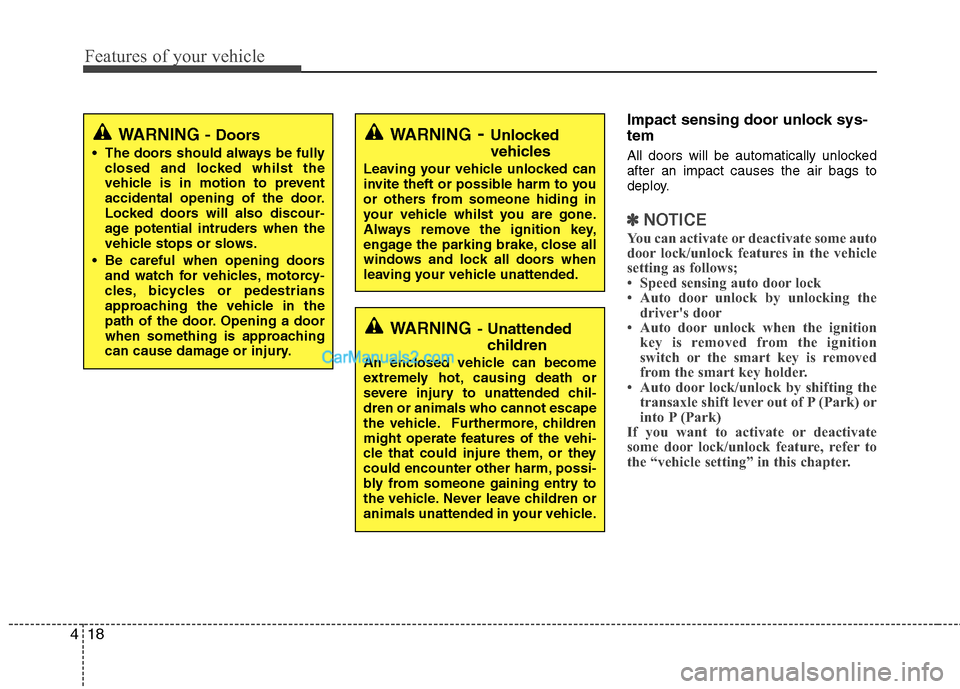
Features of your vehicle
18
4
Impact sensing door unlock sys- tem
All doors will be automatically unlocked after an impact causes the air bags to
deploy.
✽✽
NOTICE
You can activate or deactivate some auto
door lock/unlock features in the vehicle
setting as follows;
Speed sensing auto door lock
Auto door unlock by unlocking the driver's door
Auto door unlock when the ignition
key is removed from the ignition
switch or the smart key is removed
from the smart key holder.
Auto door lock/unlock by shifting the transaxle shift lever out of P (Park) or
into P (Park)
If you want to activate or deactivate
some door lock/unlock feature, refer to
the “vehicle setting” in this chapter.
WARNING - Unlocked
vehicles
Leaving your vehicle unlocked can
invite theft or possible harm to you
or others from someone hiding in
your vehicle whilst you are gone.
Always remove the ignition key,
engage the parking brake, close all
windows and lock all doors when
leaving your vehicle unattended.
WARNING - Unattended
children
An enclosed vehicle can become
extremely hot, causing death or
severe injury to unattended chil-dren or animals who cannot escape
the vehicle. Furthermore, children
might operate features of the vehi-
cle that could injure them, or they
could encounter other harm, possi-
bly from someone gaining entry to
the vehicle. Never leave children or
animals unattended in your vehicle.
WARNING - Doors
The doors should always be fully closed and locked whilst the
vehicle is in motion to prevent
accidental opening of the door.
Locked doors will also discour-
age potential intruders when the
vehicle stops or slows.
Be careful when opening doors and watch for vehicles, motorcy-
cles, bicycles or pedestrians
approaching the vehicle in the
path of the door. Opening a door
when something is approaching
can cause damage or injury.